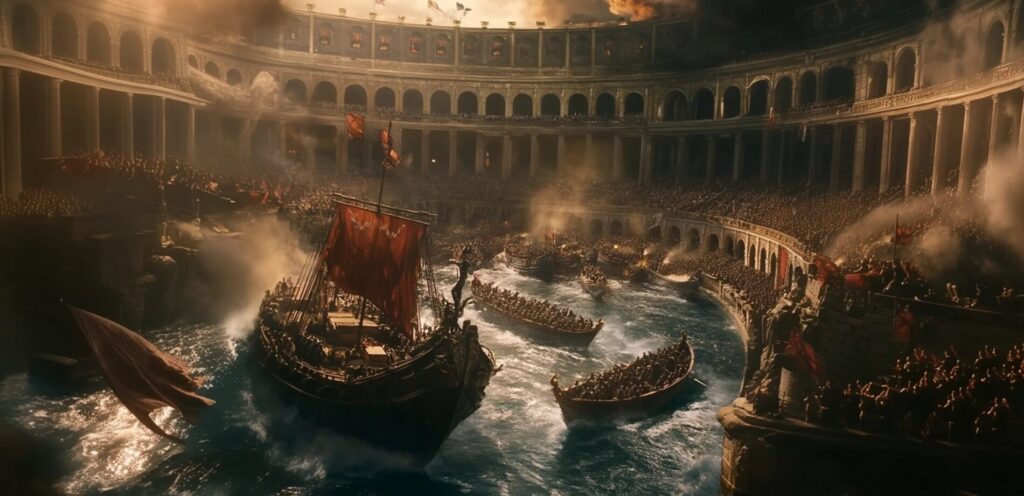Ridley Scott’s ‘Gladiator 2’ Faces Claims of ‘Total Hollywood Bulls*’—But Surprising Historical Truths Back Up the Story

The Colosseum: A Marvel of Ancient Engineering
Architectural and Historical Significance
The Colosseum, a lasting emblem of ancient Rome, exemplifies the architectural brilliance and engineering skill of the Roman Empire. Built under the Flavian emperors, this grand amphitheater was designed to host a wide array of public spectacles. Its elliptical design, accommodating tens of thousands of spectators, demonstrates the Romans’ advanced construction techniques and crowd management strategies. Beyond entertainment, the Colosseum served as a venue for social interaction and a display of imperial power, reinforcing Rome’s cultural and political dominance.
Entertainment in Ancient Rome
As the heart of Roman entertainment, the Colosseum hosted events ranging from gladiatorial contests to dramatic reenactments of historical battles. These spectacles were central to Roman culture, providing a platform for emperors to gain public favor and assert their authority. The events were meticulously organized, featuring elaborate set designs and diverse participants, including gladiators, wild animals, and even naval vessels. These spectacles were not only leisure activities but also reflections of the societal values and hierarchical structures of ancient Rome.
FUN FACT: The first known naumachia was given by Julius Caesar in Rome in 46 BC on occasion of his quadruple triumph. After having a basin dug near the Tiber, capable of holding actual biremes, triremes and quinqueremes, he made 2,000 combatants and 4,000 rowers, all prisoners of war, fight.
Naumachiae: The Staged Naval Battles
Historical Accounts of Naumachiae
Naumachiae, or staged naval battles, were among the most extravagant entertainments in ancient Rome. Historical records indicate that these events were first introduced by Julius Caesar and later popularized by subsequent emperors. Occasionally, the Colosseum was transformed into a vast aquatic arena, allowing for the recreation of naval engagements. These spectacles were meticulously planned, involving the construction of elaborate sets and the use of real ships and combatants, vividly portraying Roman naval prowess.
Execution and Challenges
Executing naumachiae required significant logistical planning and engineering expertise. Flooding the arena involved a complex system of aqueducts and drainage channels, showcasing the Romans’ mastery of hydraulic engineering. Despite their grandeur, these events posed challenges, including the risk of structural damage to the Colosseum and the safety of participants. Successfully staging naumachiae demonstrated the organizational capabilities of Roman authorities and their commitment to providing unparalleled entertainment.
Gladiator 2: Bridging History and Fiction
Creative Liberties in Cinematic Storytelling
Ridley Scott’s film “Gladiator 2” seeks to capture the grandeur of ancient Roman spectacles, including the naumachiae. While the film takes creative liberties in its portrayal of historical events, it draws inspiration from documented practices of the time. The narrative blends factual elements with fictional storytelling, engaging audiences while providing a glimpse into the past. This approach, though sometimes criticized for historical inaccuracies, highlights the enduring fascination with Roman history and its cultural legacy.
The Role of Historical Consultants
In producing “Gladiator 2,” historical consultants play a crucial role in ensuring authenticity. These experts provide insights into the historical context, advising on aspects such as costume design, set construction, and event depiction. Their contributions help bridge the gap between historical fact and cinematic fiction, allowing filmmakers to create a more immersive and credible portrayal of ancient Rome. The collaboration between filmmakers and historians underscores the importance of historical accuracy in media, enhancing the educational value of such productions.
The Impact of Historical Films on Public Perception
Historical films like “Gladiator 2” significantly influence public perception of ancient history. By dramatizing historical events, these films introduce audiences to the complexities of past societies, sparking interest and encouraging further exploration. While primarily aimed at entertainment, they also serve an educational purpose, providing a visual representation of historical narratives. The portrayal of ancient Rome in “Gladiator 2” offers viewers an opportunity to engage with history dynamically and accessibly, fostering a deeper appreciation for the cultural heritage of the Roman Empire.
